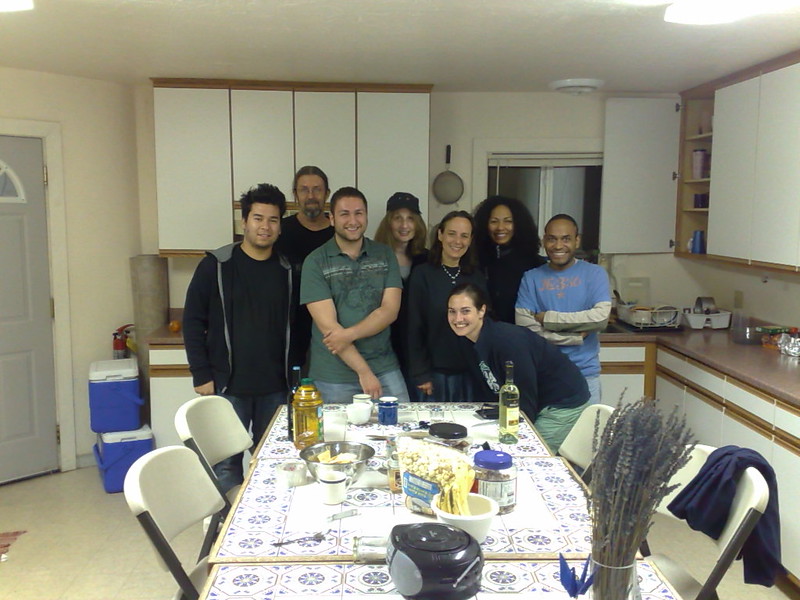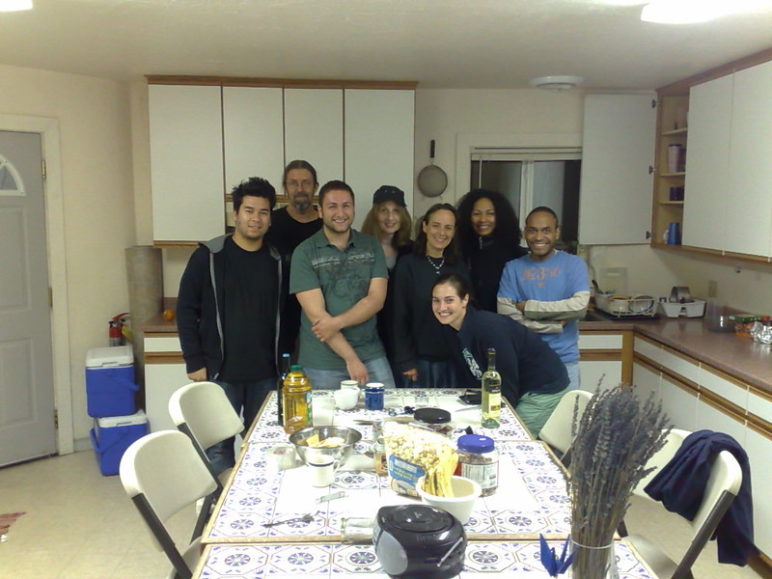Update, 2/28/20: On Friday, the House Local Government Committee approved a striker amendment to SB 6302 that stripped away the heart of the bill: a prohibition on discriminatory occupancy laws. The striker instead only requires that cities with unrelated occupancy limits offer a process for owners to obtain an exemption after meeting a long list of discretionary review standards. Details here.
It may surprise progressive Washingtonians to learn that many of their cities bar those who don’t fit into a stereotypical nuclear family from living together.
Buried deep in municipal codes across Washington (and America, for that matter) are provisions that limit the number of “unrelated occupants” who can live in a home, while any number of related people can live together. This discriminatory language can prevent unmarried couples, blended families, elderly residents, and low-income people from sharing homes, splitting expenses, and finding community.
Two weeks ago, the Washington State Senate took action by passing SB 6302 to strike down arbitrary limits on unrelated occupants. The bill, introduced by Sen. Christine Rolfes (D-Bainbridge), would instead direct cities to rely solely on code requirements that cap the number of residents according to the home’s size, regardless of family relation.
“I started thinking about this issue because I was thinking about retired women living together…sort of like some of us [legislators live together] in Olympia,” Rolfes said at a Jan. 20 public hearing on the bill. “In many cities, that wouldn’t be allowed.”
She added that these rules make it more expensive for those who want to live with others, don’t mind sharing rooms or bathrooms, and can’t afford their own one-bedroom apartment. SB 6302 would ensure all Washington cities allow these economical group living arrangements and free up more affordable alternatives from existing housing stock.
SB 6302 would unlock some of the 1 million empty bedrooms hiding in plain sight
Unrelated occupancy limits not only impose exclusionary definitions of “family,” but also worsen the state’s housing crisis.
On any given night, over a million of Washington’s bedrooms sit empty. Occupancy limits aren’t the sole reason for these vacancies, but they are one factor preventing people from renting out unused space.
Occupancy limits can make it illegal to take perfectly reasonable steps like filling a large house’s vacant bedrooms with housemates or renting out a mother-in-law suite. What’s more, unrelated occupancy limits don’t even prevent overcrowding because they aren’t tied to the size of a dwelling: city zoning laws apply the same limit to a large mansion as to a studio apartment.
What unrelated occupancy limits actually do is exclude low-income people from neighborhoods. By limiting the number of “roommates,” cities shut out cheaper options for residents to share housing costs and pay lower rents. Exposing the classism embedded in these rules, some cities went so far as to allow exceptions for “live-in servants”: you’re allowed to have as many housemates as you want if you’re also rich enough to employ them (see: City of Yakima).
Unrelated occupancy limits also discriminate against unmarried couples and blended families. By legally defining who counts as a “family,” the laws ban families that don’t fit the nuclear mold from living together. Some cities exempt residents in state-registered domestic partnerships from counting towards unrelated occupancy limits, but not all cities do.
It’s 2020—who are city bureaucrats to define what families look like? A few states have already answered that question definitively: State courts in California, Michigan, New Jersey, and New York have struck down unrelated occupancy limits, supporting the case for state legislative action in Washington and elsewhere.
Most Washington cities ban homes with more than five unrelated residents, but some city limits run even lower
I grew up in a family of six. My family could live together in any Washington city, but six unrelated adults could not legally reside in a single home in most Washington cities.
Of the 228 Wasington cities Sightline surveyed, 162 (71 percent) impose limits on unrelated occupants. (This count excludes allowances for unrelated people living together for medical care or other support.) The average Washington city bans households with more than five unrelated residents. But, some city codes place even lower limits on unrelated residents.
Kent, WA
Unrelated Occupancy Limit: Four
In late 2019, the city of Kent reduced its occupancy limit from five to four unrelated residents. Kent is the sixth largest city in Washington and has become more racially diverse in recent years, partly due to Seattle’s rising housing costs pricing out people of color and pushing them to move further south.
Kent’s recent move to further restrict unrelated residents will only make it harder for people to find inexpensive shared housing. As is typical of Washington cities, most of Kent’s housing stock consists of single-detached houses, which tend to be larger than apartments. A cap of only four unrelated people in a home—regardless of its size. This not only mandates inefficient use of some space, but robs low- and middle- income residents of affordable housing options.
Bellingham, WA
Unrelated Occupancy Limit: Three
Home to Western Washington University, Bellingham’s largest age demographic is 20 to 24. College students commonly room with other students to share housing costs. Yet Bellingham enforces one of the strictest limits in the state, barring more than three unrelated people from living together.
The median rent in Bellingham rose by 30 percent from 2010 to 2017. By eliminating economical housing options through unrelated occupancy limits, college towns create another financial barrier to higher education for students from low- and middle-income families already struggling under the weight of tuition and fees.
Hunts Point, WA
Unrelated Occupancy Limit: Zero
Hunts Point, a town of 420 people, is one of the wealthiest places in the state, with a median home value of over $2 million. Nestled among the exclusive suburbs of Medina, Clyde Hill, and Yarrow Point on the shores of Lake Washington, Hunts Point is a beacon of wealth unfathomable to most Washingtonians. Few of the town’s residents are likely in need of roommates to cut living costs, but that’s sort of the point: less wealthy people couldn’t legally live in Hunts Point even if they tried. Not legally, that is, unless they’re hired live-in help: city rules exclude any “domestic service workers, gardeners, caretakers, and contract laborers” from its unrelated resident count.
Hunts Point’s outrageously exclusive code outlaws cohabitation of all families headed by unmarried couples, and any family with even a single unrelated member. The city’s zoning code defines a dwelling unit as for the use of a single family and it defines a family only as “one person or two or more related people” living together. Most other cities’ codes include additional language establishing the number of unrelated people who can live together as a “family” or “household”, but Hunts Point neglects such provisions entirely, effectively barring unrelated people from living together at all. They may be a family to one another, but the law says they’re not.
Hunts Point may well never enforce this law—unrelated occupancy limits are notoriously difficult to enforce. But if that’s the case, there’s no reason for the city to object to a state law than bans such laws.
Next Steps for SB 6302
Now that the Senate passed SB 6302, the House will have a chance to deliberate on the bill. Yesterday, the bill had its first House hearing before the House Committee on Local Government and the committee must pass the bill by Monday for it to proceed.
With this small code fix, the state can free up thousands of vacant bedrooms, increase housing options for low- and middle-income residents, and make its cities fairer and more inclusive of all the family structures and living arrangements we see today.
In 2017, Iowa passed a similar bill banning unrelated occupancy limits, with bipartisan support. Will Washington legislators give the state-level direction we need to address this issue that pervades over 100 jurisdictions? Or will they allow cities to continue to legislate the nuclear family mold?










BK
Wow. I think of myself as pretty informed and jaded about the classism infecting policy here, but I learned something from this article. The rot runs deep. Thanks.
Nisma
That it does. Thanks for reading the article! You can read more of our work on unrelated occupancy limits here: https://www.sightline.org/tag/occupancy-limits/
Erik
The author missed an angle here. Most jurisdictions put limits on what constitutes a family not to be purposely classist, but in order to distinguish between “single-family homes” and “lodging/boarding houses” in zoning codes. Regardless of the merit of this approach or the proposed law, it’s important to discuss the potential unintended consequence of forcing cities to approve a Holiday Inn next door to someone’s home.
Dan Bertolet
Is there any difference between a boarding house and a single-family home other than the legal relationship status of the occupants and whether they’re owners vs. renters? Seems to me that banning boarding houses is all about classism, no?
What exactly are the unintended consequences you mean?
Nisma
I’ll add to Dan’s point that most cities use the International Property Maintenance guidelines (see here: https://codes.iccsafe.org/content/IPMC2015/chapter-4-light-ventilation-and-occupancy-limitations) that limit the number of occupants per sq ft. As long as homes meet these basic standards, I don’t see the risk is posed by allowing more people to live in unused habitable space. Additionally, the bill doesn’t apply to short-term rentals.
Todd Aschoff
So Urbanists want to regulate AirBnB but not cash”rent to your extended friends “? So AZbB could use your Costco or AARP membership as an identity familial and poof- endless transient boarding fraying stable neighborhoods. Is their proof that enforcement is an issue?
Jonathan S
How frequently are the occupancy limits enforced? If most people don’t know the limits exist, and they have rarely been enforced, then I don’t see how eliminating the limits will have much of an impact on the housing crisis.
Sherri Schultz
You would be informed of said limits by City staff if you went to them with, say, the idea of establishing a housing co-op or co-living residence in a 10-BR house.
These limits limit innovation in housing and creative solutions that maximize dwelling space.
CWhalen
In that event, it opens the doors to rules being applied arbitrarily to people who someone in charge dislikes.
Jonathan Betz-Zall
I’m interested in how household-sharing could help with the double crisis in housing policy: not only affordability but eroding sense of community. Members of the Northwest Intentional Community Association have had considerable success addressing both elements. If public agencies were to encourage large-scale community building [which MUST be done on a voluntary basis], sharing of those unused bedrooms could have a significant effect on the double crisis.
Bill Popp
While I agree with the notion that the proposal will help with the housing affordability issue, what is overlooked in this conversation is the nuisance and blight that can result from the vehicles that these adult dwellers typically own. Recently was looking at a neighborhood near the airport for on-street parking supply and was astounded at the number of vehicles along shoulders and even in yards.
Michael Andersen
Pick your poison, Bill. It’s true that even in big cities, most Americans own cars, but that’s because we’ve refused to make proximal housing both legal and affordable for enough people. Without addressing housing affordability and proximity in urban areas, we’ll be stuck with a whole country’s worth of polluting clunkers for a dangerously long time.